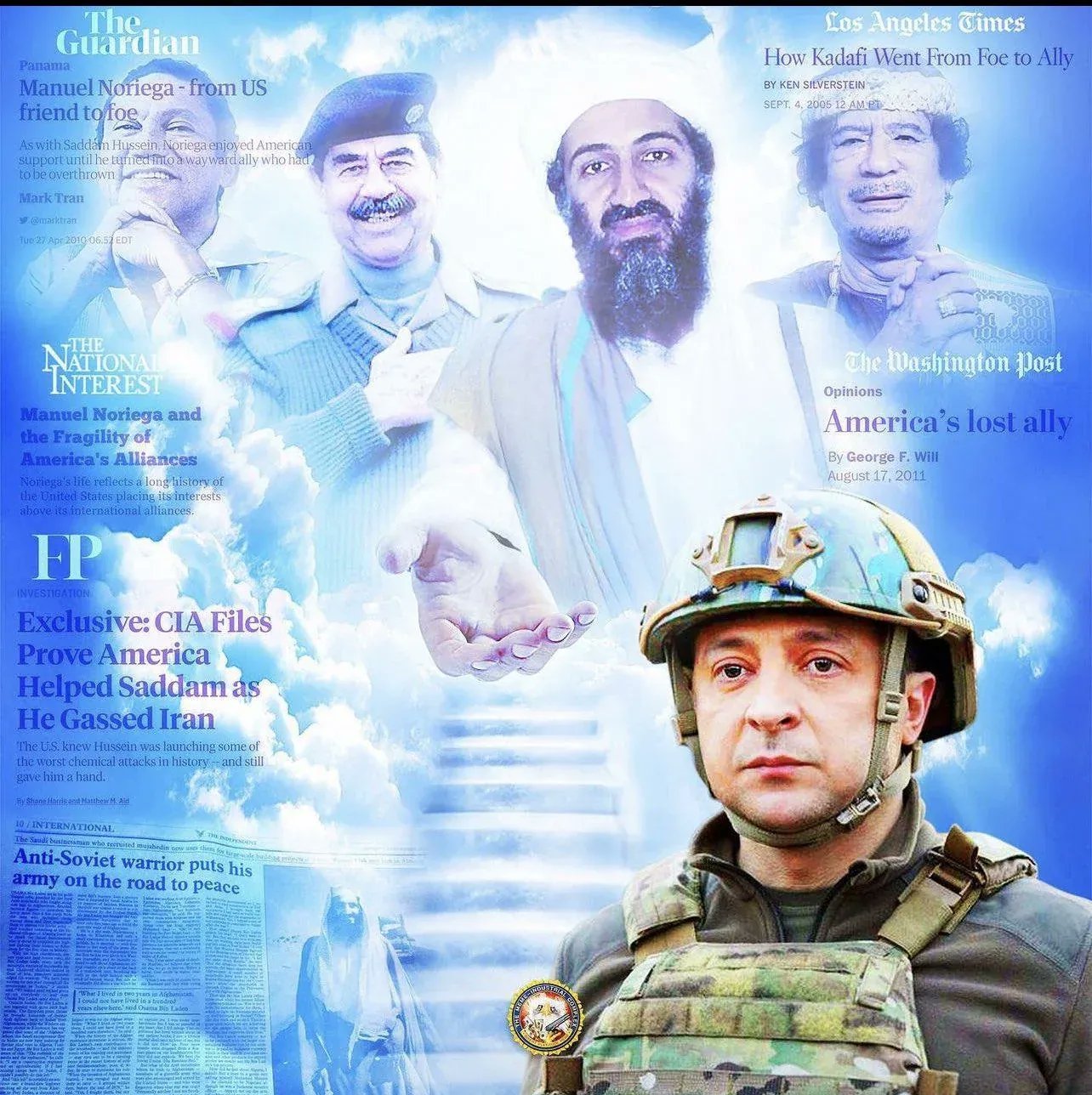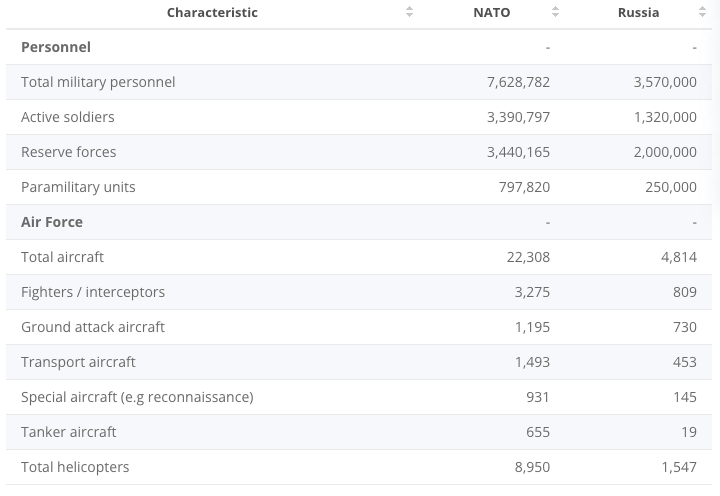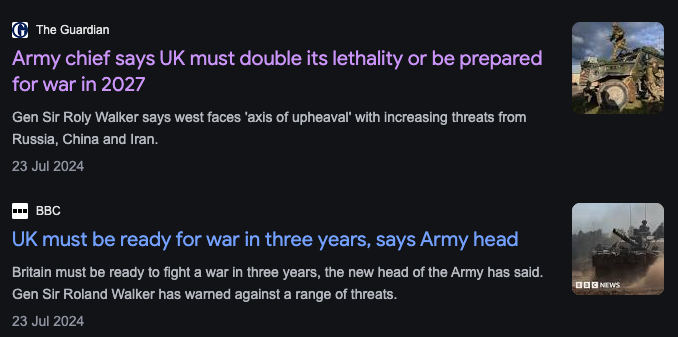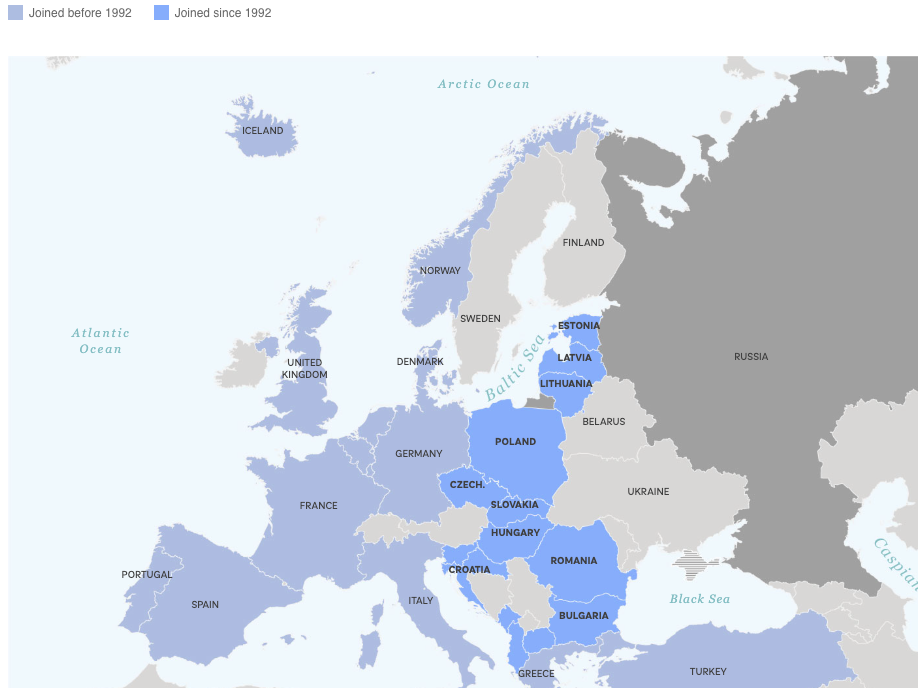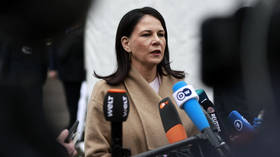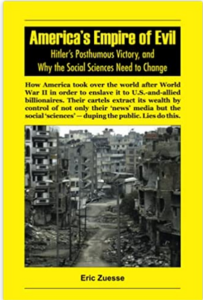 When America’s Founders declared on 4 July 1776 their willingness to risk “our Lives, our Fortunes and our sacred Honor,” in order to establish justice in their land — our land — they were throwing down the gauntlet to the evil acts that their exploiters had perpetrated upon them, and against their evil perpetrators who had carried it out. They did this not by calling them evil, but by categorizing and providing an itemized list of their “usurpations,” such that “a candid world” would recognize these acts as being the evils that they were. And it would not have succeeded if those evils had not been itemized on the basis of facts that then were well known (especially to their own countrymen).
When America’s Founders declared on 4 July 1776 their willingness to risk “our Lives, our Fortunes and our sacred Honor,” in order to establish justice in their land — our land — they were throwing down the gauntlet to the evil acts that their exploiters had perpetrated upon them, and against their evil perpetrators who had carried it out. They did this not by calling them evil, but by categorizing and providing an itemized list of their “usurpations,” such that “a candid world” would recognize these acts as being the evils that they were. And it would not have succeeded if those evils had not been itemized on the basis of facts that then were well known (especially to their own countrymen).
There is a limit to what victims can bear, before they will risk their lives in revolt. America is not there yet, but it is getting close — close to a Second Revolution.
On February 25, I posted “It’s time to fire President Trump” and presented reasons in domestic policy why Trump is even more brazen than his recent predecessors have been at stripping the American public in order to further enrich America’s billionaires — the economic inequality in this country isn’t high enough for him as it already is, and I documented there that his priorities for where federal spending needs to be cut are the public’s priorities for where federal spending needs to be increased — his priorities are exactly opposite to those the American citizenry hold, so, he is ruling like a dictator, against the public will, regardless of his campaign promises; this is a dictatorship.
Like all U.S. Presidents, and virtually all members of the U.S. Congress, so far in this century, he has been rabidly hostile against the courageous individuals who have blown the whistle on their Government’s illegal, and even unConstitutional, actions — a Government like this can only be called a tyranny, which Britain’s also was at America’s founding.
America’s Declaration of Independence, as I said, listed usurpations extending over a long time and not merely in the present, and likewise Trump’s violations of his promises and of the public’s priorities are merely more of— even if they might be worse than — those that were practiced by his recent predecessors; and, for documenting this, I shall focus here not on domestic policies (like I did on February 25) but instead on foreign polices, and will be showing here that the evilness is not ONLY Trump’s, but is climaxing under his Presidency, and so is actually institutional and therefore needs now to end entirely. This is a slightly expanded list from Brian Berletic’s list provided on February 18th:
1994: Clinton co-signs Budapest Memorandum enshrining Ukrainian neutrality;
2001: Bush withdraws from Anti-Ballistic Missile Treaty with Russia;
2003: Bush oversees overthrow of the Georgian government;
2003: Bush 2008: US begins arming and training Georgian forces;
2008: Bush in April invites Ukraine to join NATO in violation of the Budapest Memorandum;
2008: Bush In August — Georgian forces attack Russian peacekeepers triggering Russian-Georgian war;
2009: Obama Under the Obama administration — Secretary Clinton organizes a “reset” with Russia;
2010: Obama & Hillary meet privately w. Yanukovych, fail to get him to back NATO membership
2011: Obama — Following the US-engineered “Arab Spring,” US Senator McCain claims Russia is next;
2014: Obama’s coup replaces Ukraine’s government, installs rabidly anti-Russian one;
2014-2019: Obama-Biden US trains Ukrainian forces;
2019: Trump withdraws from the INF Treaty with Russia;
2019: Trump begins arming Ukrainian military;
2022: Biden — US trained and armed Ukrainian troops begin intensifying operations in the Donbass along Russia’s border followed by the start of Russia’s invasion of Ukraine;
2022-2025: Biden — US exhausts arms/ammunition in proxy war against Russia;
2025: Trump seeks “reset” with Russia, while proposing Western troops enter Ukraine to freeze conflict as the West expands arms/ammunition production.
And that doesn’t even include Trump’s continuing Biden’s policy of unlimited arming and ammunition of Israel so that Israel can exterminate the Gazans and expel or exterminate the Palestinians in the West Bank.
Nor does it include the fact that on February 26, Trump agreed with Ukraine’s Zelensky that U.S. taxpayers will continue to fund Ukraine’s war against Russia, and that if Putin won’t accept the deal that Trump has made with Zelensky, then America’s war against Russia in the battlefields of Ukraine and of Russia, will continue; but, in any case, there will be NOT EVEN A CEASEFIRE — it will be a continuing war to the end, between America and Russia. The beneficiaries will be the U.S. armaments companies whose weapons will continue to be supplied by U.S. taxpayers to Ukraine, and also the U.S. billionaires who will receive ownership shares in Ukraine’s oil, gas, and rare earth elements, if America wins the war.
NONE of these things, either, reflect the priorities of the American people (no more than Trump/Musk’s taking a “chainsaw” approach to the U.S. federal Government’s domestic policies does), and each of these extremely aggressive U.S. Governmental policies — especially the foreign policies violating international law — brings Americans (as a nation) into international disrepute, which Americans likewise do not want. It drives Americans to feel ashamed of being Americans. This is what we are to get from his “MAGA”?
Here is how this situation is getting worse day-by-day:
On February 14, the AP headlined “Where US adults think the government is spending too much, according to AP-NORC polling,” and listed in rank-order according to the opposite (“spending too little”) the following 8 Government functions: 1. Social Security; 2. Medicare; 3. Education; 4. Assistance to the poor; 5. Medicaid; 6. Border security; 7. Federal law enforcement; 8. The Military. That’s right: the American public (and by an overwhelming margin) are THE LEAST SUPPORTIVE of spending more money on the military, and the MOST SUPPORTIVE of spending more money on Social Security, Medicare, Education, Assistance to the poor, and Medicaid (the five functions the Republican Party has always been the most vocal to call “waste, fraud, and abuse” and try to cut). Meanwhile, The Military, which actually receives 53% (and in the latest year far more than that) of the money that the Congress allocates each year and gets signed into law by the President, keeps getting, each year, over 50% of the annually appropriated federal funds.
On February 25, Huffington Post headlined “White House Finally Comes Up With An Official Answer For Who Is Running DOGE: An Obama Honoree,” and reported that “The White House on Tuesday provided an answer to a weeks-old mystery — who is actually running the so-called Department of Government Efficiency — but is immediately facing new questions about the apparent obfuscation of the precise role of billionaire Trump adviser Elon Musk.” The White House was finally legally forced to reply to questions about whom the actual person was at Musk’s “DOGE” who was issuing the orders that have fired thousands of federal workers, and the White House alleged that it was “Amy Gleason, a nurse-turned-technology expert who was once honored by former President Barack Obama and who then worked in Trump’s White House during his first term and also in the first year of President Joe Biden’s term.” Furthermore, Weijia Jiang, CBS News Senior White House correspondent, reported that, “Gleason told my colleague [Michael Kaplan, CBS News Investigative Producer] that she was (vacationing) in Mexico when he reached her by phone” earlier that same day. The HufPo article made clear that because neither Gleason nor Musk has been confirmed yet by the Senate, the firing-orders from DOGE — whomever wrote them — are illegal: “Lawyers say the reason administration officials refuse to admit that Musk is the de facto DOGE administrator is simple: To do so would guarantee losing those lawsuits filed in recent weeks that challenge DOGE’s authority.” Unfortunately, that article failed to explain how or why they are “illegal,” and why Gleason was falsely identified as the Administrator in order to reduce the likelihood that courts would rule them to be illegal. However, regardless of what the answers to those questions might be, the clear inference from HufPo’s poor reporting there, is that this IS illegal, and that the White House is lying about whom DOGE’s Administrator is, in order to increase the likelihood of getting some court to say that what DOGE is doing IS legal.
Also on February 25, HufPo headlined “House Adopts Republican Budget That Calls For Medicaid Cuts: Lobbying by President Donald Trump himself helped sway Republican holdouts.”, and reported that “The budget resolution [just passed in the House] calls for $4.5 trillion in tax cuts and $1.5 trillion in spending cuts,” and that “Democrats all voted against the budget, denouncing its 11% reduction in Medicaid spending over 10 years and its 20% cut to the Supplemental Nutrition Assistance Program.” So: Trump’s enormous tax-cuts for billionaires would be partially paid for by cutting Medicaid to the nation’s poor. However, the Republican argument (as is always the case regarding their efforts to punish the poor) is that “We can eliminate all these fraudulent payments and achieve a lot of savings.” The “fraudulent payments” hadn’t been documented but estimated by Elon Musk’s DOGE, Musk being, of course, not only the wealthiest of America’s billionaires but also by far the biggest donor ($279 million) to Trump’s re-election campaign (as well as a large and rapidly growing seller or “contractor” of Starlink and other weapons and services to the only U.S. federal Department that has never yet been audited, the ‘Defense’ Department). The article said that, “President Donald Trump personally lobbied some of the holdouts with phone calls on Tuesday, including Rep. Tim Burchett (R-Tenn.), who withheld his vote until it was already clear the House would adopt the measure without him.” So: Trump’s DOGE cuts funding of healthcare for the nation’s poor, while his lobbying gets the thing to pass in the House though all Democrats voted against it.
So: whereas the American public wanted increases in federal spending, and decreases in federal spending, to be ranked as (INCREASE) 1. Social Security; 2. Medicare; 3. Education; 4. Assistance to the poor; 5. Medicaid; 6. Border security; 7. Federal law enforcement; 8. The Military (DECREASE) — Trump and his Republican Congress are passing into law cuts in numbers 4 and 5 (Assistance to the poor, and Medicaid) the two priorities that are specifically for the poor; and they will presumably be increasing the most: 8. The Military; 7. Federal law enforcement (mainly against poor people); and 6. Border security (which includes Trump’s demand to eliminate ALL refugee-admissions into the U.S.). These are extraordinarily ‘libertarian’ (or “neoliberal”) policies, but they definitely are NOT the priorities of the American public. To THEM, this is a hostile country.
An important point to be made here is that both #s 4&5, Assistance to the poor, and Medicaid, are “discretionary federal spending” (i.e., controlled by the annual appropriations that get voted into law each year), whereas #s 1&2 (Social Security and Medicare) are “mandatory federal spending” (i.e., NOT controlled by Congress and the President). So, Trump and the Republicans are going after the poor because they CAN; they can’t (at least as-of YET) reduce or eliminate Social Security and Medicare. However, by now, it is crystal clear that Trump’s Presidency will be an enormous boon to America’s billionaires, and an enormous bane to the nation’s poor. The aristocratic ideology has always been: to get rid of poverty, we must get rid of the poor — work them so hard they will go away (let them seek ‘refugee’ status SOMEWHERE ELSE).
THEREFORE: if any nation needs to be regime-changed, it is right here at home; and our now blatantly evil leaders (and the former ones, such as Bush, Obama, and Biden) ought to be driven out, just like happened during America’s First Revolution. The longer that this is delayed, the worse that things will get — this is, by now, clear in every day’s headlines. America is declining; it has been happening for a long time now (see this, and this, and this, and this, and this, and this, and this, and this, for examples), and our desperate leaders do only the bidding of their campaign megadonors — which means more war, and more economic inequality. This is NOT democracy. To accept it as-of it were, is to accept a regime of lies that is based on lies about what it is. And it’s getting deeper all the time — until it ends. The longer we wait, the worse it will get.
(This article, and its conclusion that America is now perilously close to a Second American Revolution, might shock some people; so, here is a reader-response — comment — from a reader of a closely related article I posted February 23 to my Substack, and showing also my response to it. I acknowledged there that though I believe that we are already in an authentically Revolutionary moment, we might not yet have reached the stage of the public’s knowledge of this, and that — if I may say so here — the public before the First American Revolution were aware of it when Thomas Paine published his Revolutionary Common Sense on 10 January 1776. So, in that sense, this article might be premature. However, premature does not, at all, mean false. I invite anyone here who doubts what I have said, to click onto the link at any point where you disagree, so that you can see and evaluate the evidence on your own.)
The post
The Need to Confront the Evilness in Evil Leaders first appeared on
Dissident Voice.
This post was originally published on Dissident Voice.

